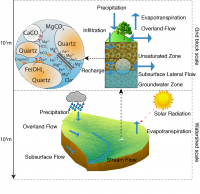CSDMS 2015 annual meeting poster ChenBao
RT-Flux-PIHM: A Coupled Hydrological, Land Surface, and Reactive Transport Model for Hydrogeochemical Processes at the Watershed Scale
Li Li, Penn State, University Park, Pennsylvania, United States.
Shi Yuning, Penn State, University Park, Pennsylvania, United States.
Abstract:
The close coupling of hydrological and geochemical processes at the watershed scale requires an integrated approach to examine their interactions and impacts. Here we present the first model that couple hydrological, land surface, and reactive transport processes, RT-Flux-PIHM, a new addition to the PIHM (Penn State Integrated Hydrological Model) family. The reactive transport module explicitly simulates geochemical reactions, including aqueous complexation, mineral dissolution and precipitation, redox reaction, gas dissolution-exsolution, adsorption and cation exchange. The reactive transport module was coupled to land surface and hydrological model in a sequential non-iterative manner with special treatment to minimize errors associated with operator splitting. This new integrated model is applied at the Susquehanna Shale Hills Critical Zone Observatory (SSHCZO) to study the controls on stream water and soil water chemistry. The temporal concentration evolution of non-reactive tracer chloride and weathering-derived magnesium in the stream water simulated in the model agreed well with measurements in 2009 with the maximum total bias less than 17% and 8%, respectively. The integration of processes in this model also helped to explain the temporal and spatial variation in pore water chloride and magnesium concentration within the watershed. Furthermore, parameter sensitivity analysis showed the van Genuchten parameter α and β, clay dissolution rates, groundwater influx rate, magnitude of annual precipitation, dissolution surface area of clays and the cation exchange site density have strong controls on the stream magnesium concentration. In summary, RT-Flux-PIHM provides a unique integration tool to understand the hydrogeochemical processes and responses to climatic, hydrological, and anthropogenic forcing at the water shed scale.

Model schematic
* Please acknowledge the original contributors when you are using this material. If there are any copyright issues, please let us know and we will respond as soon as possible.

